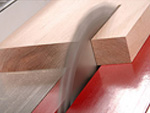
Selecting the Right Saw Blade
Today, more than ever before, there is a wider variety of blades from which to choose. While this ensures that you can find a blade for any job it can sometimes add to the confusion when selecting a saw blade. Let’s take a close look at the types of blades and sort through the terminology so that you can choose the best blade for your next job.
Today’s saw blades are remarkable testaments to engineering. But you don’t need to be an engineer to understand the basics and choose the right saw blade. Here’s a rundown of the essential terms:
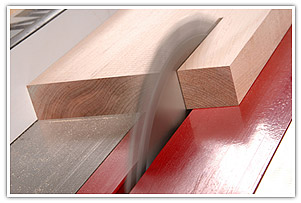
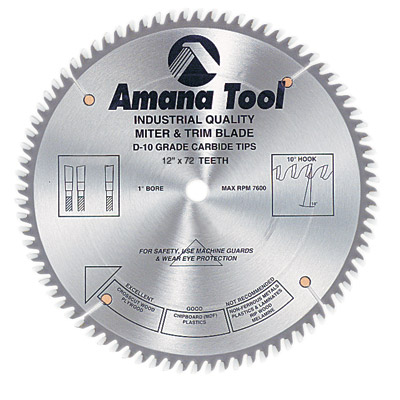
--Blade bodies heat up and expand during cutting. Expansion slots in the plate help dissipate heat and provide for expansion so that the blade remains flat and cuts true.
--Copper plugs in the slots reduce operational noise.
--Carbide teeth are specially ground on each type of blade to provide clean cuts. The finest blades have thick teeth to provide repeated sharpenings and long blade life.
--The large gullets on rip blades are designed to efficiently pull the sawdust from the kerf.
View our complete line of saw blades
Saw Blade Types
Today, there are more specialty saw blades to choose from than ever before. Although the most common sawblades are designed for ripping and crosscutting solid wood there are a number of specialty blades for cutting man-made sheet stock such as MDF and plywood, plastic coated materials such as melamine, and even demolition blades that are designed for cutting through an occasional nail.
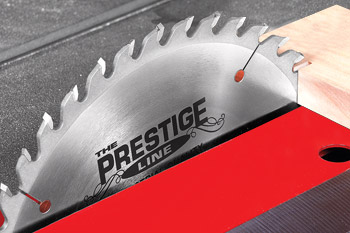
Rip blades have a fewer number of teeth than crosscut or combination blades, typically twenty to twenty-four on a ten inch blade. The low tooth count combined with large gullets and an 18 to 20 degree hook angle makes Amana rip blades fast and aggressive.
Glue-line rip blades use a special triple-chip tooth grind and an extra high hook angle. The unique tooth grind allows aggressive feed rates while at the same time producing a cut so smooth that the surface is ready for gluing—no jointing required!
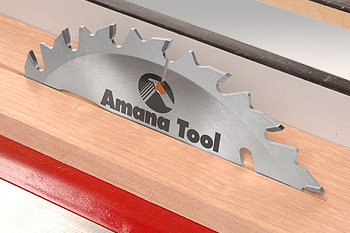
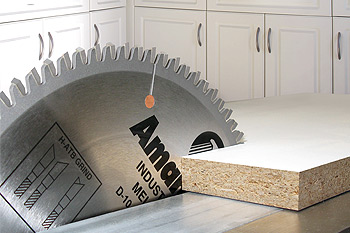
General Purpose Saw Blades
As the name implies, general purpose blades are designed to effectively rip and crosscut so that you can continue working without changing blades. General purpose blades combine a lower tooth count and larger gullets than crosscut blades so that they can rip effectively. And the alternate top bevel (ATB) tooth configuration also makes them effective for crosscutting cleanly.
I keep a combination blade 610600 on my tablesaw most of the time. As a furnituremaker I’m continually making a variety of cuts and I save a lot of time by not continually switching back and forth between rip and crosscut blades. So you’re probably thinking “why not just mount a combination blade on your tablesaw and leave it there?” The answer? It depends.
For example, if I’m ripping a few boards for a drawer, the combination blade works fine. But when ripping a large stack of hardwood stock, I’ll sometimes switch to a rip blade. The large gullets and aggressive tooth angle will smoothly and effortlessly rip all day long without bogging down the saw. And for silky-smooth miters, I use 80 tooth miter blade. The sharp 20 degree top bevel easily shears tough end-grain for gap-free miter joints. The bottom-line? You’ll often be more productive by taking a minute and switching to a specialty blade.
Let’s take a closer look at a few of the most popular styles of specialty blades and discuss how they may be put to use in your shop.
View all General Purpose Saw Blades
Crosscut Saw Blades
If you own a sliding miter saw or a radial-arm saw you’ll want a crosscut blade that is specially designed for these machines. Sliding miter saws and radial-arm saws have a tendency to self-feed which leaves the wood torn and ragged and can sometime even grab the stock—a potentially dangerous situation. The negative hook angle of radial-arm and sliding miter saw blades pushes the stock downward and against the fence to provide an extra margin of safety.
If you own a sliding miter saw or a radial-arm saw you’ll want a crosscut blade that is specially designed for these machines. Sliding miter saws and radial-arm saws have a tendency to self-feed which leaves the wood torn and ragged and can sometime even grab the stock—a potentially dangerous situation. The negative hook angle of radial-arm and sliding miter saw blades pushes the stock downward and against the fence to provide an extra margin of safety.View all Miter Saw Blades
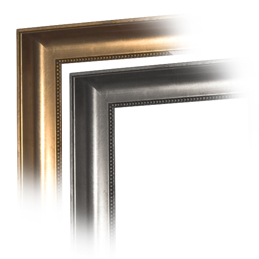
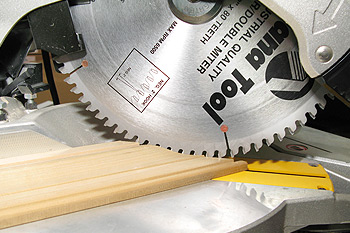
View all Non Ferrous Saw Blades
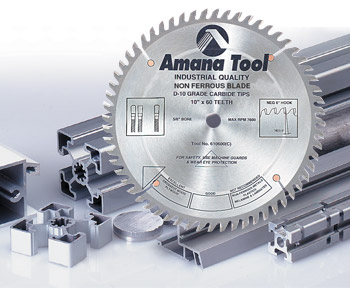
Warning! Demolition Blades are not to be used on gas powered saws.
View all Demolition Saw Blades
Saw Blade Tooth Configurations

used on rip blades for fast, efficient cuts along the grain.

an alternate left and right bevel to cleanly shear the wood fibers when crosscutting.

Steeper bevel than the standard ATB for chip-free cuts on Melamine and plastic laminate without the use of a scoring blade

Groups of four ATB teeth and one flat-ground tooth. Each group is divided by a large gullet on the saw blade. The design is used on combination blades for ripping and crosscutting.

Alternate flat raker tooth and higher trapeze tooth divides the chips to achieve smooth cuts in hard materials such as MDF, OSB, and plastics. This tooth design is also used on blades for cutting non-ferrous materials.

Specialty tooth design for miter saws. Used in picture frame shops, window and door manufacturers or anywhere that miter saws are used.
Saw Blade Tooth Angles

A hollow face grind used for cutting melamine and other challenging materials. Most often used on vertical panel saws.

The angle between the face of the tooth and an imaginary line from the blade center. Steeper angles, from 18 to 22 degrees, are most effective for ripping and cutting softer materials. Hard materials require a shallow angle such as 6 degrees. To prevent self-feeding, sliding miter saws and radial-arm saws require a blade with a negative tooth angle.

The angle between the top of the tooth and an imaginary line tangent with the cutting circle of the blade. This angle varies according to the hardness of the material being cut, 12 degrees for hard and 15 degrees for softer materials.

The angle between the top of the tooth and an imaginary line tangent with the cutting circle of the blade. This angle varies according to the hardness of the material being cut, 12 degrees for hard and 15 degrees for softer materials.
Saw Blade Maintenance
You’ll get better results and a longer life from your sawblades if you follow a few simple guidelines for their care.
Protect the teeth—carbide teeth are brittle and can be chipped or broken if dropped or allowed to contact other tooling. Use care when installing blades and store them so that they are not in contact with other blades or bits.
Keep them clean—the teeth on a sawblade undergo a tremendous amount of heat and stress during cutting. As a result, gum and dirt will build up on the tooth surfaces. Use a blade cleaner to remove the crud.
Keep them sharp—when the feed resistance begins to increase or the quality of the cut suffers slightly it’s time for sharpening. Avoid touching up the tooth surfaces yourself; you’ll risk spoiling the cutting geometry. Instead, take the sawblade to a professional saw sharpening shop and have the teeth ground.
Amana’s line is among the finest industrial-quality saw blades available. And Amana Tool has a saw blade for every woodworker, from high production furniture and cabinet plants to the small custom shops and woodworking enthusiast.
View our complete line of saw blades.

